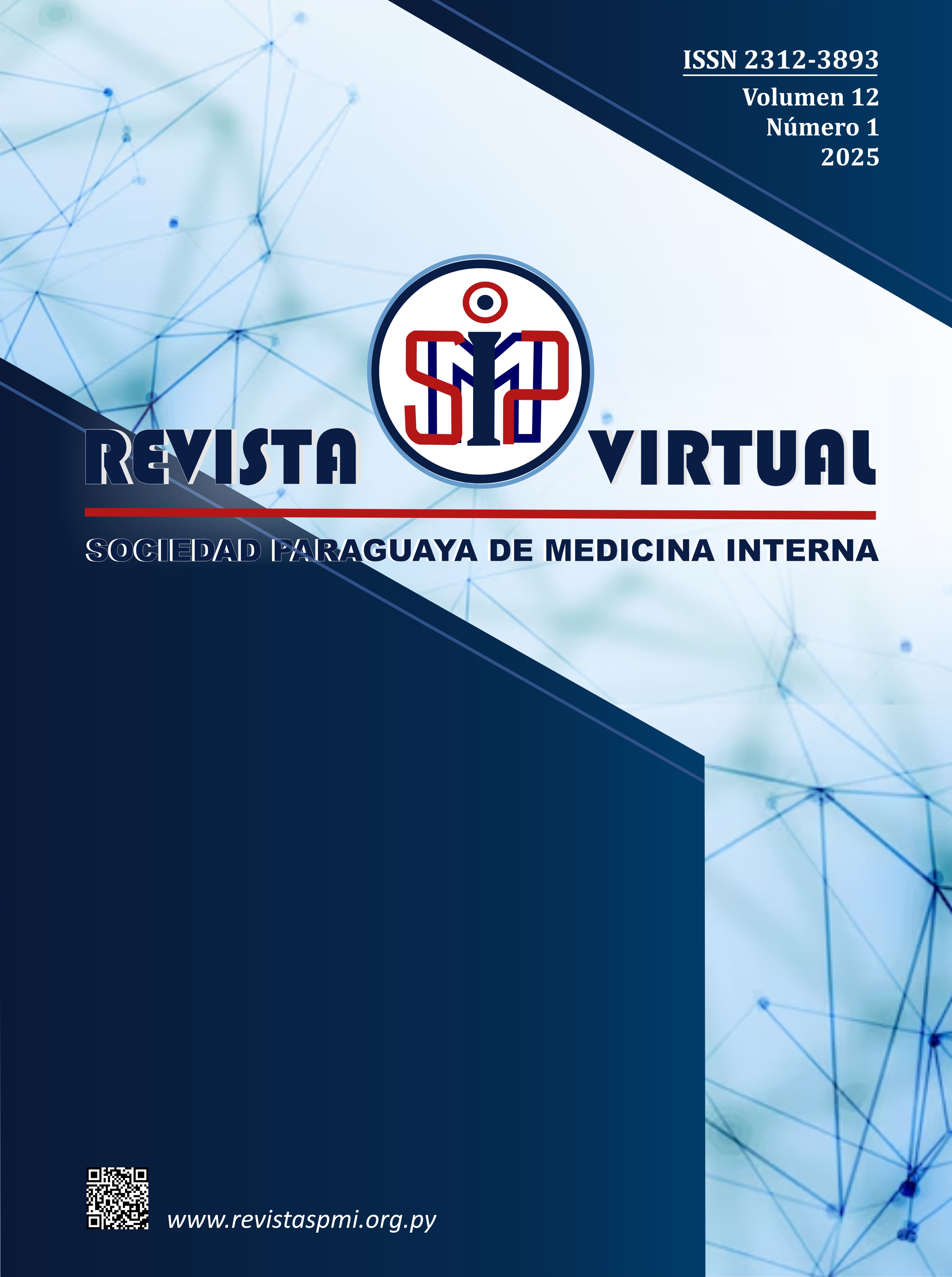Inercia terapéutica en el manejo de la hipertensión en adultos mayores: implicaciones clínicas
Resumen
Las enfermedades cardiovasculares siguen siendo la principal causa de morbilidad y mortalidad en el mundo, generando una carga de enfermedad importante en los sistemas de salud globales. La hipertensión arterial (HTA) es uno de los trastornos cardiovasculares más prevalentes en el mundo, estimándose más de 1 billón de casos a nivel global. Según datos de la Organización Mundial de la Salud, solo 2 de cada 10 personas con HTA se encuentran controlados, y uno de los objetivos de la salud global para el 2030, es reducir la prevalencia de HTA hasta en 33%. Esto puede ser causado por la omisión de intensificación de terapia farmacológica cuando se es necesario (inercia terapéutica). La inercia terapéutica es más frecuente en pacientes con alto riesgo de eventos secundarios o adversos, como lo son los adultos mayores. Se cree que este podría ser un potencial factor de riesgo de desenlaces cardiovasculares, con búsqueda de un cambio en algoritmos tradicionales y paradigmas controversiales. Sin embargo, persisten las discrepancias en la literatura respecto al abordaje de este tema. Considerando la relevancia de este y de la necesidad de conocer evidencia para cumplir con las metas de la salud global, el objetivo de esta revisión consistió en analizar críticamente la evidencia más reciente sobre la inercia terapéutica en el control de la presión arterial en adultos mayores.
Citas
2. Zhou B, Perel P, Mensah GA, Ezzati M. Global epidemiology, health burden and effective interventions for elevated blood pressure and hypertension. Nat Rev Cardiol [Internet]. 2021 [cited 2023 May 26]; 18(11):785-802. Available from: https://pubmed.ncbi.nlm.nih.gov/34050340/. doi: 10.1038/s41569-021-00559-8
3. Mills KT, Stefanescu A, He J. The global epidemiology of hypertension. Nat Rev Nephrol [Internet]. 2020 [cited 2023 May 26]; 16(4):223-37. Available from: https://pubmed.ncbi.nlm.nih.gov/32024986/. doi: 10.1038/s41581-019-0244-2
4. Nguyen TN, Chow CK. Global and national high blood pressure burden and control. Lancet. 2021; 398(10304):932-33. doi: 10.1016/S0140-6736(21)01688-3
5. Oliveros E, Patel H, Kyung S, Fugar S, Goldberg A, Madan N, et al. Hypertension in older adults: Assessment, management, and challenges. Clin Cardiol [Internet]. 2020 [cited 2023 May 26]; 43(2):99-107. Available from: https://pubmed.ncbi.nlm.nih.gov/31825114/
6. Lebeau JP, Cadwallader JS, Aubin-Auger I, Mercier A, Pasquet T, Rusch E, et al. The concept and definition of therapeutic inertia in hypertension in primary care: a qualitative systematic review. BMC Fam Pract [Internet]. 2014 [cited 2023 May 26]; 15:130. Available from: https://pubmed.ncbi.nlm.nih.gov/24989986/. doi: 10.1186/1471-2296-15-130
7. Ali DH, Kiliç B, Hart HE, Bots ML, Biermans MCJ, Spiering W, et al. Therapeutic inertia in the management of hypertension in primary care. J Hypertens. 2021; 39(6):1238-45. doi: 10.1097/HJH.0000000000002783
8. Augustin A, Coutts L, Zanisi L, Wierzbicki AS, Shankar F, Chowienczyk PJ, Floyd ChN. Impact of therapeutic inertia on long-term blood pressure control: A Monte Carlo simulation study. Hypertension [Internet]. 2021 [cited 2023 May 26]; 77(4):1350-9. Available from: https://pubmed.ncbi.nlm.nih.gov/33641362/. doi: 10.1161/HYPERTENSIONAHA.120.15866
9. Chiu N, Chiu L, Aggarwal R, Raber I, Bhatt DL, Mukamal KJ. Trends in blood pressure treatment intensification in older adults with hypertension in the United States, 2008 to 2018. Hypertension [Internet]. 2023 [cited 2023 May 26]; 80(3):553-62. Available from: https://pubmed.ncbi.nlm.nih.gov/36111537/#:~:text=Results%3A%20From%202008%20to%202018,%25)%20in%202015%20to%202018. doi: 10.1161/HYPERTENSIONAHA.122.19882
10. Kelly DM, Rothwell PM. Blood pressure and the brain: the neurology of hypertension. Pract Neurol. 2020; 20(2):100-8. doi: 10.1136/practneurol-2019-002269
11. Joyner MJ, Charkoudian N, Wallin BG. Sympathetic nervous system and blood pressure in humans: individualized patterns of regulation and their implications. Hypertension [Internet]. 2010 [cited 2023 May 26]; 56(1):10-6. Available from: https://pubmed.ncbi.nlm.nih.gov/20497993/. doi: 10.1161/HYPERTENSIONAHA.109.140186
12. Ashton N. Neurological and humoral control of blood pressure. Anaesth Intensive Care. 2007; 8(6):221-6.
13. O’Donohoe PB, Pandit JJ. Neurological and humoral control of blood pressure. Anaesth Intensive Care. 2016; 17(5);253-7.
14. Raven PB, Chapleau MW. Blood pressure regulation XI: overview and future research directions. Eur J Appl Physiol [Internet]. 2014 [cited 2023 May 26]; 114(3):579-86. Available from: https://pubmed.ncbi.nlm.nih.gov/24463603/. doi: 10.1007/s00421-014-2823-z
15. Shahoud JS, Sanvictores T, Aeddula NR. Physiology, arterial pressure regulation [Internet]. In: StatPearls. Treasure Island (FL): StatPearls Publishing; 2023. [cited 2023 Dec 9] Available from: https://www.ncbi.nlm.nih.gov/books/NBK538509/
16. Rendón-Ariza A, Urueta-Gaviria MJ, Contreras-Cabeza JJ, Carrera-Patiño SA, Lozada-Martínez ID. Systemic hemodynamic atherothrombotic syndrome in the young: An early phenotype of established cardiovascular disease?. J Pract Cardiovasc Sci [Internet]. 2021 [cited 2023 May 26]; 7(2):168-9. Available from: https://journals.lww.com/jpcs/fulltext/2021/07020/systemic_hemodynamic_atherothrombotic_syndrome_in.11.aspx. doi: 10.4103/jpcs.jpcs_44_21
17. Aguas-Salazar OC, Villaveces-Buelvas MA, Martínez-Ocampo JC, Lozada-Martinez ID. Systemic hemodynamic atherothrombotic syndrome: The real agent to consider for 24-h management of hypertension and cardiovascular events. Indian J Med Spec [Internet]. 2021 [cited 2023 May 26]; 12(4):235-6. Available from: https://journals.lww.com/imsp/fulltext/2021/12040/systemic_hemodynamic_atherothrombotic_syndrome_.11.aspx. doi: 10.4103/injms.injms_94_21
18. Rodríguez Castillo AA, Hoyos Moncada JA, Moreno Sarmiento A, Castro Salas SP, Lozada Martinez ID. Síndrome aterotrombótico hemodinámico sistémico: ¿es causa de enfermedad arterial coronaria no estenosante en el joven? Rev méd Trujillo [Internet]. 2022 [citado 26 May 2023]; 17(3):078-9. Disponible en: https://revistas.unitru.edu.pe/index.php/RMT/article/view/4554. doi: https://doi.org/10.17268/rmt.2022.v17i3.4554
19. Lozada-Martinez ID, Hernández-González MI, Villarreal-Montenegro CV, Motta-Hernández JW, Arias-Leon NP, Moscote-Salazar LR. Clinical inertia in the management of patients with post-COVID 19 neurological syndrome: a problem without current evidence. Arch Neurocien [Internet]. 2024 [cited 2024 Ago 26]; 29(2): 5-7. Available from: https://archivosdeneurociencias.org/index.php/ADN/article/view/406. doi: https://doi.org/10.31157/an.v29i2.406
20. Moscote-Salazar LR, Janjua T, Picon-Jaimes YA, Lozada-Martinez I, Barros C, Paez-Nova M, Agrawal A. Clinical inertia: The care gap between clinical guidelines and clinical practice in neurotrauma. J Neurointensive Care [Internet]. 2022 [cited 2024 May 26]; 5(1):33-5. Available from: https://www.e-jnic.org/journal/view.php?number=68#:~:text=Clinical%20inertia%20is%20a%20concept,goals%20established%20from%20the%20beginning. doi: https://doi.org/10.32587/jnic.2021.00437
21. Milman T, Joundi RA, Alotaibi NM, Saposnik G. Clinical inertia in the pharmacological management of hypertension: A systematic review and meta-analysis. Medicine (Baltimore) [Internet]. 2018 [cited 2024 May 26]; 97(25): e11121. Available from: https://pubmed.ncbi.nlm.nih.gov/29924011/. doi: 10.1097/MD.0000000000011121
22. Gembillo G, Ingrasciotta Y, Crisafulli S, Luxi N, Siligato R, Santoro D, Trifiró G. Kidney disease in diabetic patients: From pathophysiology to pharmacological aspects with a focus on therapeutic inertia. Int J Mol Sci [Internet]. 2021 [cited 2024 May 26]; 22(9):4824. Available from: https://pubmed.ncbi.nlm.nih.gov/34062938/. doi: 10.3390/ijms22094824
23. Rivara MB, Bansal N, Young B. Therapeutic inertia and racial differences in blood pressure control-time to get moving. JAMA Netw Open [Internet]. 2022 [cited 2024 May 26]; 5(1):e2143008. Available from: https://pubmed.ncbi.nlm.nih.gov/35006251/. doi: 10.1001/jamanetworkopen.2021.43008
24. Zheutlin AR, Mondesir FL, Derington CG, King JB, Zhang Ch, Cohen JB, et al. Analysis of therapeutic inertia and race and ethnicity in the systolic blood pressure intervention trial: A secondary analysis of a randomized clinical trial. JAMA Netw Open [Internet]. 2022 [cited 2024 May 26]; 5(1): e2143001. Available from: https://pubmed.ncbi.nlm.nih.gov/35006243/. doi: 10.1001/jamanetworkopen.2021.43001
25. Fontil V, Pacca L, Bellows BK, Khoong E, McCulloch ChE, Pletcher M, Bibbins-Domingo K. Association of differences in treatment intensification, missed visits, and scheduled follow-up interval with racial or ethnic disparities in blood pressure control. JAMA Cardiol [Internet]. 2022 [cited 2024 May 26]; 7(2):204-12. Available from: https://pubmed.ncbi.nlm.nih.gov/34878499/. doi: 10.1001/jamacardio.2021.4996
26. Whitford DL, Al-Anjawi HA, Al-Baharna MM. Impact of clinical inertia on cardiovascular risk factors in patients with diabetes. Prim Care Diabetes. 2014; 8(2):133-8. doi: 10.1016/j.pcd.2013.10.007
27. Sudharsanan N, Theilmann M, Kirschbaum TK, Manne-Goehler J, Azadnajafabad S, Bovet P, et al. Variation in the proportion of adults in need of blood pressure-lowering medications by hypertension care guideline in low- and middle-income countries: A cross-sectional study of 1 037 215 individuals from 50 nationally representative surveys. Circulation [Internet]. 2021 [cited 2024 May 26]; 143(10):991-1001. Available from: https://pubmed.ncbi.nlm.nih.gov/33554610/. doi: 10.1161/CIRCULATIONAHA.120.051620
28. Anderson TS, Wray ChM, Jing B, Fung K, Ngo S, Xu E, et al. Intensification of older adults' outpatient blood pressure treatment at hospital discharge: national retrospective cohort study. BMJ [Internet]. 2018 [cited 2024 May 26]; 362: k3503. Available from: https://pubmed.ncbi.nlm.nih.gov/30209052/. doi: 10.1136/bmj.k3503
29. Mu L, Mukamal KJ. Treatment intensification for hypertension in US ambulatory medical care. J Am Heart Assoc [Internet]. 2016 [cited 2024 May 26]; 5(10): e004188. Available from: https://pubmed.ncbi.nlm.nih.gov/27792661/. doi: 10.1161/JAHA.116.004188
30. Flack JM, Cheema A. Therapeutic nihilism in older hypertensives: A resounding call to action. Hypertension [Internet]. 2023 [cited 2024 May 26]; 80(3):563-5. Available from: https://pubmed.ncbi.nlm.nih.gov/36791221/. doi: 10.1161/HYPERTENSIONAHA.122.20091
31. Brunton S. Therapeutic inertia is a problem for all of Us. Clin Diabetes [Internet]. 2019 [cited 2024 May 26]; 37(2):105-6. Available from: https://pmc.ncbi.nlm.nih.gov/articles/PMC6468832/. doi: 10.2337/cd19-0009
32. Khunti S, Khunti K, Seidu S. Therapeutic inertia in type 2 diabetes: prevalence, causes, consequences and methods to overcome inertia. Ther Adv Endocrinol Metab [Internet]. 2019 [cited 2024 May 26]; 10:2042018819844694. Available from: https://pubmed.ncbi.nlm.nih.gov/31105931/. doi: 10.1177/2042018819844694
33. Josiah Willock R, Miller JB, Mohyi M, Abuzaanona A, Muminovic M, Levy PD. Therapeutic inertia and treatment intensification. Curr Hypertens Rep [Internet]. 2018 [cited 2024 May 26]; 20(1):4. Available from: https://pmc.ncbi.nlm.nih.gov/articles/PMC6452867/. doi: 10.1007/s11906-018-0802-1
34. Nesbitt SD. Overcoming therapeutic inertia in patients with hypertension. Postgrad Med. 2010; 122(1):118-24. doi: 10.3810/pgm.2010.01.2105
35. Pantoja MV, Lozada-Martinez ID. Polypharmacy and therapeutic inertia in extreme longevity: A potential clinical ageism scenario secondary to important gaps in clinical evidence. J Prev Med Public Health [Internet]. 2024 [cited 2024 May 26]; 57(5):508-10. Available from: https://pubmed.ncbi.nlm.nih.gov/39384174/. doi: 10.3961/jpmph.24.364
36. Lozada-Martinez ID, Hernandez-Paez DA, Palacios Velasco I, Martínez Guevara D, Liscano Y. Meta-research in geriatric surgery: Improving the quality of surgical evidence for older persons in a multidimensional-scale research feld. J Clin Med [Internet]. 2024 [cited 2024 Ago 26]; 13(18):5441. Available from: https://www.mdpi.com/2077-0383/13/18/5441. doi: https://doi.org/10.3390/jcm13185441
37. Lozada-Martinez ID, Ealo-Cardona CI, Marrugo-Ortiz AC, Picón-Jaimes YA, Cabrera-Vargas LF, Narvaez-Rojas AR. Meta-research studies in surgery: a field that should be encouraged to assess and improve the quality of surgical evidence. Int J Surg [Internet]. 2023 [cited 2024 Ago 26]; 109(6):1823-4. Available from: https://pubmed.ncbi.nlm.nih.gov/37144675/. doi: 10.1097/JS9.0000000000000422
38. Lozada-Martinez ID, Bolaño-Romero MP, Picón-Jaimes YA, Moscote-Salazar LR, Narvaez-Rojas AR. Quality or quantity? Questions on the growth of global scientific production. Int J Surg [Internet]. 2022 [cited 2024 Ago 26]; 105:106862. Available from: https://pubmed.ncbi.nlm.nih.gov/36031070/. doi: 10.1016/j.ijsu.2022.106862
39. Crowley MJ, Smith VA, Olsen MK, Danus S, Oddone EZ, Bosworth HB, Powers BJ. Treatment intensification in a hypertension telemanagement trial: clinical inertia or good clinical judgment? Hypertension [Internet]. 2011 [cited 2024 Ago 26]; 58(4):552-8. Available from: https://www.ahajournals.org/doi/10.1161/HYPERTENSIONAHA.111.174367?doi=10.1161/HYPERTENSIONAHA.111.174367. doi: https://doi.org/10.1161/HYPERTENSIONAHA.111.174367
40. Niriayo YL, Girmay S, Tesfay N, Gidey K, Asgedom SW. Therapeutic inertia and contributing factors among ambulatory patients with hypertension. BMC Cardiovasc Disord. 2024 Sep 27;24(1):523. Available from: https://pubmed.ncbi.nlm.nih.gov/39333861/ doi: 10.1186/s12872-024-04109-1.

















